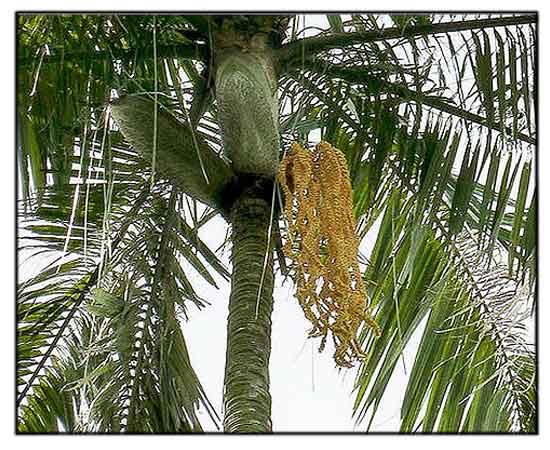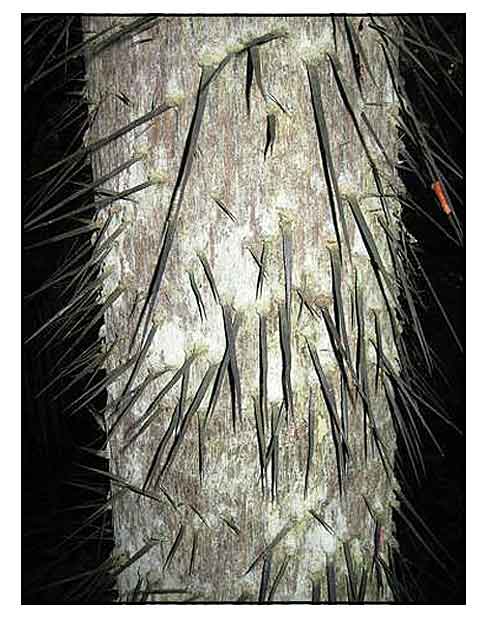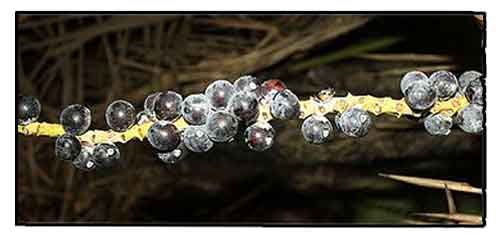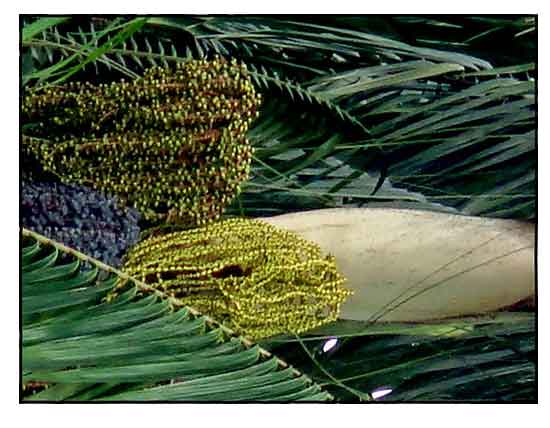 Gen info Gen info
- Oncosperma is a genus of flowering plants i the family Arecaceae. It contains the following species native to Southeast Asia and Sri Lanka: Oncosperma fasciculatum Thwaites, O. tigillarium (Jack) Riidl.), O. gracilipes Becc., O. horridum (Griff.) Scheff., and O. platyphyllum Becc. The last three are found in the Philippines. (2) There are reports that O. tigillarium is native to Palawan.
- Some compilations use the common name Nibung for both Oncosperma horridum and O. tigillarium. Some list them as separate species. (3)
- Oncosperma horridum is very similar to and may be confused with the congener Oncosperma tigillarium, from which can be distinguished because it forms tufts with few stems or even with a solitary stem, as well as for the bigger leaves that display almost plain pinnulae, instead than elegantly drooping as in O. tigillarium. (4)
- Etymology: The genus name Oncosperma derives from Greek words oncos (protuberance) and sperma (seed), referring to the surface of the seeds. The species epithet horridum derives from Latin horridus, meaning "bristling, shaggy, or very prickly", referring to the prickles or thorns in the trunk. (4)
- Medicinally understudied plant.
Botany
• Bayas is a slender palm that grows in clusters of 4–6 stems or more, and has very dense crowns. Its stem can grow up to 20 m tall, and is covered with black prickles. Foliage: It produces pinnate leaves, whose leaflets are arranged closely and neatly on both sides of the rachis, like the teeth of a comb. Flowers: Its spirally arranged flowers are unisexual, and develop on up to 61 cm-long flowering shoots. Fruits: Its fleshy fruits are round, slightly flattened, waxy, black, one-seeded, and 1.5–1.8 cm across, with finely pimpled surfaces. Its seeds are round. (5)
 • Oncosperma horridum is a multi stemmed species, often even solitary, that can form tufts of 4-10 thin erect stems reaching the height of 30 m and the diameter of 25 cm, towering over the trees of the tropical forest. Gray stems are covered by black acuminate thorns facing down, up to 10 cm long, and are marked by brown rings in correspondence to the bases of the fallen leaves. The large crown is formed by pinnate leaves, slightly arcuate, even more than 3 m long. The bright green pointed pinnulae are uniformly arranged on the sides of the rachis on only one level, slightly drooping, up to 50 cm long and 3 cm broad. Leaves are carried by dark thorny petioles up to 1 m long ending in a green-grey sheath wrapping completely the trunk, up to 1 m long, thorny too. Great yellow inflorescences come out under the sheath in correspondence to the rings on the stem and are ramified and thorny, up to 60 cm long. Initially, they are enclosed in a grey spathe, deciduous and very thorny. They display flowers distributed spirally all over the length, arranged in triads formed by two male flowers and one female. Fruits are oval, waxy, initially of green colour, then brown and finally black when ripe, with 1,5-2 cm of diameter. (4) • Oncosperma horridum is a multi stemmed species, often even solitary, that can form tufts of 4-10 thin erect stems reaching the height of 30 m and the diameter of 25 cm, towering over the trees of the tropical forest. Gray stems are covered by black acuminate thorns facing down, up to 10 cm long, and are marked by brown rings in correspondence to the bases of the fallen leaves. The large crown is formed by pinnate leaves, slightly arcuate, even more than 3 m long. The bright green pointed pinnulae are uniformly arranged on the sides of the rachis on only one level, slightly drooping, up to 50 cm long and 3 cm broad. Leaves are carried by dark thorny petioles up to 1 m long ending in a green-grey sheath wrapping completely the trunk, up to 1 m long, thorny too. Great yellow inflorescences come out under the sheath in correspondence to the rings on the stem and are ramified and thorny, up to 60 cm long. Initially, they are enclosed in a grey spathe, deciduous and very thorny. They display flowers distributed spirally all over the length, arranged in triads formed by two male flowers and one female. Fruits are oval, waxy, initially of green colour, then brown and finally black when ripe, with 1,5-2 cm of diameter. (4)
Distribution
- Native to the Philippines.
- Also native to Borneo, Malaya, Sulawesi, Sumatera, Thailand. (1)
- In lowland forests up to mountain slopes at an altitude of up to 1,500 m with crowns sometimes reaching up to the canopy of rainforest.
 Constituents Constituents
- Seed lipids of O. horridum include: Octanoic acid; decanoic acid; dodecanoic acid; tetradecanoic acid; hexadecanoic acid; tridecenoic acid, 13-(2-cyclopenten-1-yl)-; octacecadienoic acid, octadecenoic acid, octadecanoic acid. (8)
Parts used
Shoots.
 Uses Uses
Edibility
- Apical bud is edible; cooked and eaten as vegetable.
Folkloric
- In Chinese traditional medicine, use for anti-inflammatory and antibacterial properties.
- In Malaysia, used for fever.
- In East Kalimantan, shoots eaten as remedy for headache.
(7)
Others
- Construction uses: Robust and elastic stems used for house construction, as foundation and flooring. Resistant to saltiness and rotting, they are used for constructing boats and in making kelungs, wooden structures on the sea for farming or catching fish. (4)
- Crafts: Leaves used for weaving baskets.
- Masticatory: Seeds are sometimes used as a betel (Areca catechu) substitute. (6)
Studies
• Seed Lipids: (see constituents above) (8)
Availability
Wild-crafted. |

![]()



 Gen info
Gen info


